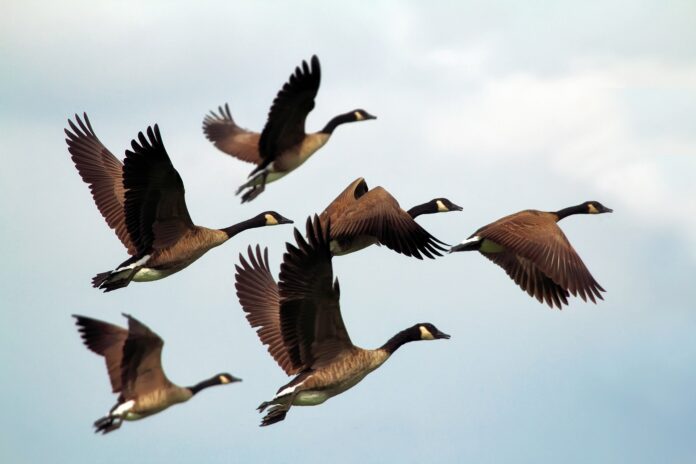Unveiling the Mystery of Bird Migrations
Birds, those skilled aviators of the animal kingdom, embark on awe-inspiring journeys during bird migration. Among them, the red knot, a salmon-colored sandpiper, undertakes a biannual migration covering thousands of miles between its wintering grounds in northern Mexico and breeding sites in the Arctic tundra. However, this incredible odyssey is fraught with challenges, from brightly lit cities disrupting nighttime journeys to threats like rising sea levels imperiling crucial wetlands at stopover sites.
The Information Gap in Bird Migration Research
Despite the mesmerizing spectacle of bird migrations, a significant information gap exists in understanding the details of these journeys. This knowledge void is especially critical in the face of a concerning statistic – the loss of an estimated 3 billion birds in North America since 1970. The need to comprehend the full annual cycles of migratory birds, including migration routes and wintering sites, is emphasized by Bill DeLuca, a senior migration ecologist with the National Audubon Society.
The challenge, as DeLuca points out, lies in the lack of knowledge about the specific times of the year causing declines for many bird species. For the majority of migratory birds, the comprehensive life cycle picture remains incomplete due to technological limitations. Until recently, scientists could study birds at their North American breeding sites, but tracking them individually throughout migrations or in wintering grounds, especially smaller songbirds, proved elusive.
Bridging the Technology Gap: Motus Wildlife Tracking System
A Beacon of Hope for Bird Migration Research
In response to the technology gap, the Motus Wildlife Tracking System emerged as a beacon of hope. Launched in 2014, Motus is an international network comprising approximately 1,800 radio receiver stations across 34 countries. While it initially gained prominence in eastern North America, this innovative system has rapidly expanded its footprint across the Western regions in recent years.
The Motus Workflow
Motus operates by equipping birds with small tags that weigh less than 3 percent of the bird’s weight. For example, a tag for a small songbird weighing around 18 grams is a mere half a gram. These lightweight tags, attached to birds like backpacks using harnesses, enable researchers to track their movements with unprecedented accuracy. When a tagged bird comes within range of a Motus station—up to approximately 12 miles away—the tag automatically transmits a signal to the receiver, and the data is then uploaded to the Motus website.
Unlocking Mysteries: Motus in Action
Motus has proven to be a game-changer, particularly in the Western regions where understanding bird movements has lagged behind the East. The Pacific flyway, hosting an estimated 1 billion migratory birds, and the central flyway in the interior West witness the passage of millions more. Through Motus, researchers can monitor and analyze the challenges these birds face, ranging from natural phenomena like storms to man-made obstacles such as glass facades and the expanding footprint of wind and solar projects.
Motus in Grassland Bird Research
Matt Webb, an avian ecologist with the Bird Conservancy of the Rockies, underscores Motus’s significance in addressing knowledge gaps about grassland songbirds. Four species, experiencing rapid population declines, became the focus of Motus-assisted research. Covering vast geographic ranges during breeding, wintering, and migration, these grassland birds present unique challenges for traditional monitoring methods.
Global Collaborations: Motus Fostering Research Networks
Motus embodies a philosophy of collaboration. Researchers, regardless of their geographic location, contribute to the network’s growth. Once a Motus tower is installed, it can detect any bird tagged by Motus collaborators worldwide. The collective data, available on the Motus website, offers a comprehensive view of bird movements, fostering a global research community.
Motus Beyond Birds: A Multispecies Approach
Motus extends its impact beyond avian species, embracing a multispecies approach. Over 340 species, including bats and insects, have been tagged using Motus. The network’s flexibility allows researchers to investigate migratory patterns and threats common to various species. For instance, Motus is now assisting a team from the U.S. Geological Survey in monitoring seabirds and bats to assess potential impacts of offshore energy developments.
Case Studies: Motus Unveiling Migration Secrets
Grassland Birds in Northern Mexico
Matt Webb’s Motus project focused on grassland birds in northern Mexico, aiming to fill knowledge gaps about their migration routes. Through Motus, Webb and his team successfully tracked a Baird’s sparrow from Chihuahua to northern Kansas, unveiling detailed migratory stops in North American grassland habitats for the first time.
Shorebirds in Northwest Mexico
Julián Garcia Walther, a Mexican biologist, seized the opportunity to monitor red knots, shorebirds wintering in northwest Mexico, using Motus. Overcoming challenges in capturing dispersed shorebirds, Garcia Walther’s Motus stations provided critical data, revealing intriguing behaviors such as the use of dried seagrass as rafts during high spring tides.
Drought Impact on Shorebirds in California
Blake Barbaree, a senior ecologist at Point Blue Conservation Science, leverages Motus to investigate the impact of drought on shorebirds in California. With Motus towers detecting bird movements, Barbaree emphasizes the importance of understanding migratory connectivity, linking wintering grounds, breeding sites, and critical stopover habitats.
Motus: A Catalyst for Conservation
Amplifying Conservation Efforts
Motus’s growth amplifies conservation efforts by providing a wealth of data on migratory patterns and threats. For Bill DeLuca of the Audubon Society, understanding the life cycles of different species is a crucial step in addressing factors contributing to their decline, such as habitat loss or pollution. Climate change emerges as a significant overarching pressure affecting bird migration directly and indirectly.
Future Prospects: Motus as a Catalyst for Change
As Motus continues to expand and collect more data, scientists gain the flexibility to address a myriad of questions. The network’s collaborative nature facilitates cross-border and cross-disciplinary research, inspiring a holistic understanding of migratory species beyond birds.
Conclusion: Shaping a Sustainable Future for Migratory Birds
In the face of declining bird populations and the challenges posed by climate change, Motus emerges as a powerful tool reshaping our understanding of bird migrations. By illuminating the intricate journeys of avian species, Motus not only enriches scientific knowledge but also serves as a catalyst for conservation actions. As the Motus network grows, so does our ability to navigate the complexities of migratory connectivity, providing a glimmer of hope for the preservation of these extraordinary, globe-trotting aviators.










